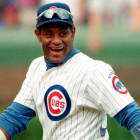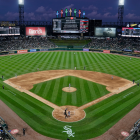On Wednesday night, the Los Angeles Dodgers fell to the Washington Nationals in Game 5 of the National League Divisional Series. The Dodgers were, as a result, eliminated from the postseason. There was a moment in the bottom of the ninth, however, where it appeared that Will Smith had saved the day for L.A. with a walk-off home run. Smith thought so, the fans in attendance thought so, and so did various other Dodgers in the dugout:
Based on the bat flip Will Smith just launched on a flyout, he is among the people who feel the ball has been un-juiced for the playoffs.
— Stephanie Apstein (@stephapstein) October 10, 2019
Reaction of #Dodgers bench after a deep drive from the bat of Will Smith that looked like the game winner in 9th inning. pic.twitter.com/RW1kRhdlO8
— James E. Clark 3 (@EVT_JClark) October 10, 2019
Alas, right fielder Adam Eaton caught the ball up against the wall, permitting the Nationals another opportunity to bat. The Nationals took advantage of that chance by putting up a four-spot, via Howie Kendrick's grand slam, on their way to the NL Championship Series.
Regardless of rooting interests on Wednesday, it was fair to wonder after Smith's flyout if the balls had been altered again. After all, this was the season of the home run. It sure felt like Smith's should've carried over the fence and given the Dodgers their walk-off victory.
Thanks to Rob Arthur's work at Baseball Prospectus, we now know it isn't just a "feel" thing. On Thursday, Arthur published an article suggesting that the league has introduced a different baseball during the playoffs, and it's having a massive impact on the games.
Let's walk through some questions you might have about Arthur's article and the baseball.
What is an altered baseball?
When we talk about the altered baseball -- or, the "juiced ball," as you've heard it referenced to -- what we mean is that the innate characteristics of the ball are different than past iterations.
This can manifest in various ways, but research conducted separately by Arthur and by Dr. Meredith Willis has found that the ball has a different "pill" composition as well as lower seams.
How do those changes impact the ball?
Essentially, it boils down to the ball's aerodynamic qualities. Arthur has found that the 2019 baseball has less "drag" -- something that commissioner Rob Manfred has conceded, too. What that means, in layperson terms, is that the ball carries farther when struck -- it doesn't get "caught" by air resistance.
If you've watched baseball during the 2019 regular season, you've likely seen balls that felt like flyouts clear the fence. That's the effect of reduced drag.
How is "drag" measured?
Arthur has taken to quantifying the drag coefficient by measuring how much speed pitches lose from their release until they cross the plate using data from Statcast, the league-operated ball-tracking system. In 2017, he found that the "changes in ball drag explain about 25 percent of the variation in the ratio of home runs to fly balls over the last four years."
Do note that following the 2017 season Major League Baseball commissioned a report from a group of scientists to study what had happened with the ball. They couldn't figure out the "why," but they did identify that the reduced drag as the leading cause for the home-run binge, thus confirming Arthur's initial findings.
What evidence is there that the ball has changed in the postseason?
In addition to measuring drag on fastballs throughout this postseason, and finding that the "probability that a random selection of games from the rest of the regular season would feature as much air resistance as we've seen so far in the postseason is about one in one thousand," Arthur constructed a statistical model using exit velocity, launch angle, and a park factor to gauge the likelihood of any given batted ball clearing the fence. It too suggests something has changed during the postseason, with the other evidence supporting a ball change.
How is that impacting the game?
In a potentially major way. Remember, these teams and their strategies were assembled from results and outputs gathered from the juiced balls. If the ball is no longer flying as it did in June or August or even September, then that would inherently mean the game has changed in a way that would -- with proper time -- prompt strategic shifts on a pitch-by-pitch basis.
Besides, the home run is the only offensive event that guarantees a run -- and that, in turn, can be a game-changing occurrence. What kind of impact is the apparently re-altered ball having on home runs? To again quote Arthur, "this model predicted that there should have been 24 more home runs so far in the playoffs than the 43 that were actually hit -- an astounding 50 percent difference."
For a more recent example, consider how things would be different today if Smith's batted ball had cleared the fence as a result of reduced drag coefficient.
Can't this be explained by cooler temperatures?
It's October, which should mean the temperatures are down and that ball distances are being suppressed naturally, right? Maybe in the past, but not anymore. As Arthur notes, the average game time temperature during the playoffs has been higher than that of the regular season.
Wouldn't pitchers have noticed any of this?
Yes they have. And a few have even spoken out, including Justin Verlander at the All-Star Game. There was also this odd scene from Gerrit Cole's recent playoff start, in which it appears he may have been examining the ball's seams, perhaps in an effort to find one with more drag. (The quote in the tweet is from this Baseball Aerodynamics blog post.)
What if Cole is feeling the difference between a high & low seam ball to reduce HRs? 🤔
— Rob Friedman (@PitchingNinja) October 9, 2019
"[I]t is very easy to see and feel the differences in these two balls. If you are an MLB pitcher in the playoffs, and a home run will kill you right now, better get a high-seam ball" pic.twitter.com/Llzyndv6rh
Is MLB intentionally tweaking the ball?
Thursday, MLB issued a statement about its postseason baseballs saying "regular season and postseason balls are manufactured with the same materials and under the same process." Here's the full statement.
BREAKING: MLB issues statement on baseballs used in postseason. “Balls that are used in the Postseason are pulled from the same batches as balls used in the regular season.... only difference is the stamp placed on the ball.” Additional comments: pic.twitter.com/SX9NqfykiY
— Maury Brown (@BizballMaury) October 10, 2019
Manfred has not commented on the balls in the postseason, but did say in September that the league would take a look at possibly altering the ball ahead of the 2020 season.
MLB owns Rawlings, the ball manufacturer, and would seem positioned to suss out what exactly is going on at the Costa Rica manufacturing facility -- be it fluctuations in the equipment or labor used, or whatever.
Without putting on a tinfoil hat, it perhaps is worth acknowledging that other leagues around the world have introduced altered baseballs to improve scoring and engage fans. Mexico's did it this year (as we covered in detail), while Japan has been through similar controversies. This wouldn't even be the first time MLB has had a juiced ball issue.
Even beyond that aspect, it's admittedly hard to understand how the baseballs could change in such a dramatic fashion from -- almost literally -- one week to another by sheer chance.

















